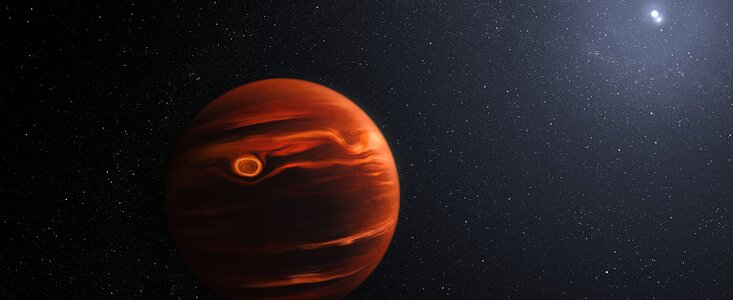This distant planet has two suns and gritty clouds; a year here lasts 10,000 years

The James Webb Space Telescope (JWST) has identified silicate clouds in the atmosphere of a distant planet. The exoplanet, catalogued as VHS 1256 b, lies about 40 light-years away from the Earth and orbits two stars over a 10,000-year period.
A team led by Brittany Miles of the University of Arizona observed VHS 1256 b as part of Webb's Early Release Science program.
The researchers detected larger and smaller silicate dust grains within the clouds. According to the team, VHS 1256 b has a low gravity compared to more massive brown dwarfs, which allows its silicate clouds to remain higher in its atmosphere where they can be detected by telescopes like Webb. The planet's young age - only 150 million years - also contributes to its turbulent atmosphere, which will continue to evolve over time.
"We've identified silicates, but a better understanding of which grain sizes and shapes match specific types of clouds is going to take a lot of additional work. This is not the final word on this planet — it is the beginning of a large-scale modelling effort to fit Webb’s complex data," Miles said.
While other telescopes have observed these features on other planets elsewhere in the Milky Way, previous research teams typically identified only one feature at a time.
"No other telescope has identified so many features at once for a single target. We’re seeing a lot of molecules in a single spectrum from Webb that detail the planet’s dynamic cloud and weather systems," said co-author Andrew Skemer of the University of California, Santa Cruz.
The team reached these conclusions by examining the spectra data gathered by two of Webb's instruments - the Near-Infrared Spectrograph (NIRSpec) and the Mid-Infrared Instrument (MIRI).
📷 The NASA/ESA/CSA James #Webb Space Telescope has observed cloud features in exoplanet VHS 1256 b's atmosphere. 🧬The planet also has the largest number of molecules detected on a planet outside of our Solar System, including water and methane.👉 https://t.co/l0Op5bBYSx pic.twitter.com/kqCK361zy7
— ESA (@esa) March 22, 2023










